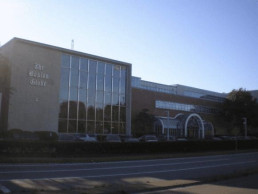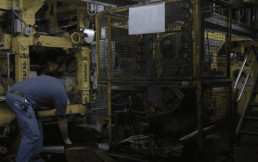
In the process of documenting Teens in Print’s twenty-year history, we had the privilege of interviewing people who played fundamental roles in the creation of the program. Today, we are honored to share the stories of Leah Bailey Moon and Marie Franklin, employees of The Boston Globe who were influential in creating Teens in Print.
Leah Bailey Moon, Executive Director of The Boston Globe Foundation from 2002 to 2010, approached WriteBoston with the idea for a student newspaper and secured The Boston Globe’s sponsorship. Moon also shared her favorite memories of working alongside our earliest student journalists, aka TiPsters.
Marie Franklin taught high school English and was an advisor for student newspapers before she became the lead reporter and columnist for The Boston Globe’s Sunday education section, known for her column “Teaching Tools.” As managing editor for the first cohort of TiPsters, she guided their writing, connected them with other writers at The Globe, and designed the publication for print.
How it Started

In 2002, Moon began working with The Boston Globe Foundation, the nonprofit affiliate of The Boston Globe. “It was an inspiring place to work,” says Moon, “I was just in awe to be at the Boston Globe building, when it was on Morrissey Boulevard.” Her first order of business was creating focus groups to find out what initiatives The Boston Globe Foundation was most interested in funding, and where there was the most need within the Boston community. She discovered that The Boston Globe staff were interested in assisting with a journalism program for Boston Public School high school students, but “reporters didn’t have the time to leave their job, go out to a high school, be an advisor to a newspaper, and then come back to their job. It just didn’t work. So we started thinking, ‘What if the students came to the globe?’”
At the time, WriteBoston writing coach Kelly Knopf-Goldner was already working with Boston Public Schools, providing students with the groundwork to express themselves through writing. She encouraged them to begin attending Teens in Print during its first year. Moon was there working directly with TiPsters alongside Knopf-Goldner every Thursday, and recalls students writing about city-wide school lunch quality, ROTC recruitment, and lateness policies, saying “the great thing about a city-wide paper, as opposed to just individual schools, was that the topics were much broader.” Working alongside Teens in Print, students interviewed Tim Russert, host of Meet the Press, during a 2005 speaking engagement at the JFK Library, across the street from the Globe’s former Morrissey Boulevard location. A PR firm connection allowed TiPsters to see movies like She’s The Man in special theaters before their release date. “You never saw people so excited,” Moon said.
When Franklin joined the staff at The Boston Globe in 2004, she was thrilled by the opportunity to support Teens in Print. Her years at suburban public high schools had demonstrated the impact of a printed student-run newspaper. “Every kid in the school read the campus newspaper. It was just a really big deal to see what was going on at school from the student perspective.” Boston Public Schools lacked the resources to offer school newspapers, so Franklin felt Teens in Print’s partnership with The Globe was a perfect way to offer this vital publication experience for Boston’s teen writers.
Through her position as a columnist, Franklin invited fellow Globe reporters and editors who assisted Teens in Print with their research. With the support of the Globe, Franklin expanded students’ horizons by organizing trips. One year, they attended seminars at Columbia University’s Journalism Institute in New York City. “At night,” Franklin recalls, “we took the kids to really fun restaurants in New York City.” On another occasion, Teens in Print toured The L.A. Times headquarters and spent an unforgettable afternoon at Disney World.
Print & Beyond

With a team of student editors, Franklin designed Teens in Print’s newspapers, which were printed by the Globe on the same in-house press that the Globe used for its regular publications until 2017. “It was so exciting when it was on the printing presses, and we’d go down and we’d look, and we’d see it coming up,” says Moon, describing the enormous machinery that printed the earliest editions of Teens in Print. “It got put in bundles on the globe trucks and got delivered to the high schools, and everybody was so proud of it.” Teens in Print was also distributed to libraries, Boys and Girls clubs, and Boston Public Schools.
Franklin, a dedicated print newspaper subscriber, recognizes that print has become a less popular method of consuming news, and young people are more likely to get their news from podcasts, videos, and/or social media, a shift that was no doubt hastened by the COVID-19 quarantine. She says “It’s really smart for Teens in Print to concentrate on the digital and to expand in the areas that youth are paying attention to.”
The Impact
Teens in Print neatly segwayed from publishing news for teens by teens into preparing students for college. Moon describes this moment for seniors as “You’ve been printed. Now, what do you do? You use your clips with your essays and your application to help you get into college.” Knopf-Goldner spearheaded college preparedness at Teens in Print, helping students write personal essays and submit their applications.
The Boston Globe Foundation was also able to offer TiPsters several college scholarships to UMass Boston, Emerson College, Hamilton College, and Amherst College throughout their partnership with WriteBoston. Both Moon and Franklin fondly remember TiPsters they worked with who have gone on to college and are now excelling in their post-college careers. Over the years, Franklin has kept in touch with many of the students she worked with through Facebook.
What are Franklin and Moon up to now?
When Moon left The Boston Globe Foundation in 2010, she moved back to the Hartford area in Connecticut to be with her daughters. She noticed there was a lack of opportunities for her grandson, who has autism with high support needs; “there was nothing for him to do on the weekend, to have fun and to meet other kids like him.” Moon and her daughter started Autism Families CONNECTicut, which offers social programs and services for kids and young adults with autism. Its 15th anniversary is next year.
Franklin left The Globe in 2009 to teach journalism at Lasell University and retired two years ago after fifty-two years in education, journalism, and journalism education. Reflecting on her time with Teens in Print, Franklin feels a deep sense of pride. “What a beautiful connection,” she says, acknowledging the combined efforts of Write Boston educators, Globe staff, and the student journalists who initiated the program. “Even though it was twenty years ago, I’m excited to know that the program still exists. I follow it on Instagram and Facebook, and I love whenever I see a post. And more importantly, I think it says something really positive about the youth of Boston… they want their voices to be heard.”
If you enjoyed this article and would like to learn more about Teens in Print’s 20-year history, please join us for Pros&Conversation on May 1st, 2025 at WBUR CitySpace. Learn more and get tickets here.